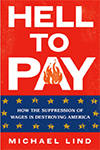Telecommuting — or telework — is a critical tool that can help employees, businesses and communities weather the current financial crisis, and thrive afterward. However, right now, the nation is burdened with a powerful threat to the growth of telework: the telecommuter tax. This tax is a state penalty imposed on Americans who work for employers outside their home states and sometimes telecommute. read more »
Economics
The Triumph Of The Creative Class
Barack Obama rode to his resounding victory on the enthusiasm of two constituencies, the young and African Americans, whose support has driven his candidacy since the spring. Yet arguably the biggest winners of the Nov. 4 vote are located at the highest levels of the nation's ascendant post-industrial business community.
Obama's triumph reflects a decisive shift in the economic center of gravity away from military contractors, manufacturers, agribusiness, pharmaceuticals, suburban real estate developers, energy companies, old-line remnants on Wall Street and other traditional backers of the GOP. In their place, we can see the rise of a different set of players, predominately drawn from the so-called "creative class" read more »
Why can't Wall Street be more like Ghana?
For the past week an irritating little tune has bounced into my head unexpectedly every time I turned to news about the financial collapse. The melody would then remain at the edge of my consciousness for hours at a time like a buzz or a hum in my ear. Though I couldn’t make out the lyrics, I could distinguish the distinct nasal whine that Rex Harrison affected in the musical My Fair Lady. Still, I couldn’t pin down which song was playing on an endless loop in my head. Instead, as I made my way through the Kotokuraba Market in Cape Coast, Ghana, this past week, I found myself absentmindedly substituting my own lyrics to the Frederick Loewe score. At first I sang the line “If only Lehman Brothers was more like the Man! Know Thyself Pharmacy,” and then “If only AIG could be more like Is Not By Might Alone Construction.” Though my feeble attempt did not come close to scanning, I knew immediately that I was onto something. read more »
San Francisco and the Meltdown
Initially San Francisco and the Bay Area market seemed to be immune to the financial meltdown resulting from the mortgage crisis. After all, the City and its accompanying affluent suburbs had not suffered drastic drops in home prices as seen in many other regions of the country. Yet as the mortgage crisis has snowballed into a complete meltdown of the worldwide financial system, the poster child of the ‘new economy’ now appears less and less immune from the turmoil dominating our news headlines.
The region that consists of the City by the Bay and the adjacent Silicon Valley is no stranger to drastic market corrections. read more »
No More Urban Hype
Just months ago, urban revivalists could see the rosy dawn of a new era for America's cities. With rising gas prices and soaring foreclosures hitting the long-despised hinterland, urban boosters and their media claque were proclaiming suburbia home to, as the Atlantic put it, "the next slums." Time magazine, the Financial Times, CNN and, of course, The New York Times all embraced the notion of a new urban epoch.
Yet in one of those ironies that markets play on hypesters, the mortgage crisis is now puncturing the urbanists' bubble. The mortgage meltdown that first singed the suburbs and exurbs, after all, was largely financed by Wall Street, the hedge funds, the investment banks, insurers and the rest of the highly city-centric top of the paper food chain. read more »
New Urbanism’s Economic Achilles Heel
By Richard Reep
Whether one believes that form follows function or that function can follow form, a town or a city needs three key elements to be healthy. Firstly, a sense of place that includes the sacred is important to people to provide a basis for spiritual involvement. The city must then be able to reliably deliver safety and security to its inhabitants in order to grow and mature. And lastly, a city must provide the means of employment for its inhabitants. read more »
Root Causes of the Financial Crisis: A Primer
It is not yet clear whether we stand at the start of a long fiscal crisis or one that will pass relatively quickly, like most other post-World War II recessions. The full extent will only become obvious in the years to come. But if we want to avoid future deep financial meltdowns of this or even greater magnitude, we must address the root causes.
In my estimation two critical and related factors created the current crisis. First, profligate lending which allowed many people to buy overpriced properties that they could not, in reality, afford. Second, the existence of excessive land use regulation which helped drive prices up in many of the most impacted markets. read more »
Industry, inequality and the middle classes
The financial collapse dominates the news, but its unregulated rise is not unrelated to the relative decline of manufacturing over the last quarter century, and the outsourcing of much of industrial production. One consequence of this de-industrialization and financialization of everything has been an astounding increase in inequality, a massive concentration of wealth at the very top and the squeezing of the middle classes.
Places that remained strong in manufacturing tend to have had and still have lower inequality than places more dependent on services, lowly to professional, and experienced a smaller change in inequality. read more »
- Login to post comments
American Elections Inspire Interest in Ghana
There’s another presidential election just around the corner here in Ghana. Current President John Kufuor is stepping down after eight years in office that has seen the gold- and cocoa-exporting West African country expand its economy and solidify its democratic credentials. Another economic stride forward is expected when Ghana begins to pump oil in 2010 or 2011. read more »
Knowledge Worker Migration: Going Where the Brains Are
At a time when national unemployment is rising, Nebraska is working overtime to attract labor. At the inaugural Sarpy County Economic Summit, Governor David Heinemann (R) talked about the need to “market the state to 16- to 20-year-olds.” Nebraska, apparently, has more jobs requiring college degrees than it has college graduates. (Interested college students can call the Director of the Nebraska Department of Economic Development, Richard Baier, at 402-471-3746.) read more »
- Login to post comments





















